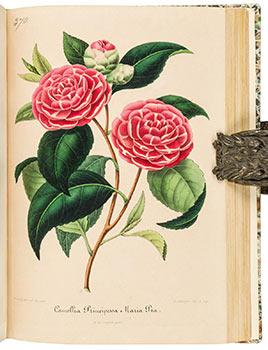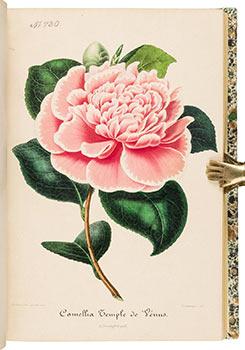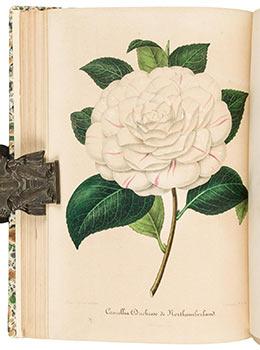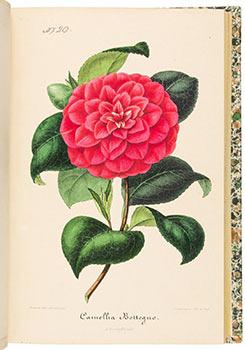VERSCHAFFELT AMBROISE EDITOR (8 résultats)
Type d'article
- Tous les types d'articles
- Livres (8)
- Magazines & Périodiques
- Bandes dessinées
- Partitions de musique
- Art, Affiches et Gravures
- Photographies
- Cartes
-
Manuscrits &
Papiers anciens
Etat
- Tous
- Neuf
- Ancien ou d'occasion
Reliure
- Toutes
- Couverture rigide
- Couverture souple
Particularités
- Edition originale
- Signé
- Jaquette (3)
- Avec images (5)
- Sans impression à la demande
Pays
Evaluation du vendeur
-
Nouvelle Iconographie des Camellias contenant les Figures et la Description de plus rares, des plus nouvelles et des plus belles variétés de ce genre. (1857).
Vendeur : Antiquariaat Wim de Goeij, Kalmthout, ANTW, Belgique
Membre d'association : ILAB
16. Gand (Gent), chez l'éditeur Ambroise Verschaffelt, Fils, Horticulteur, rue de Chaume, 1857, large in-8°, 25,5 x 17 cm, (6)nn pp + 47 (of 48) colored lithographic plates + 47 (of 48) textleaves. Missing is the plate 4 of issue 4, and the text leaf 3 of issue 4 (Targioni Rosea). Bound in contemporary black half leather, top edge gilt. Joints of binding a bit rubbed but still a fine/good copy with a very clean interior. There are only a few foxing spots on the tissue guards, 2 plates are slightly but evenly browned, all the other plates and textleaves are stainless. This is an attractive copy of one of the rarest Belgian 19th century botanical periodicals with chromolithographic plates. The publication served as an, extremely handsome and beautifully printed, catalogue to the camellia nursery which was run by the Verschaffelt family in 19th-century Ghendt. The camellia flower is very well suited to be illustrated by chromolithography which renders well the strong contrasts between the large red colored flower and its heavy dark green foliage. In all 13 years (or volumes) were published. Complete sets are now virtually impossible to find on the market. (Nissen 2056, Pritzel 9743, catalogue Hortus Belgicus, Royal Library Brussels 1962, item 46).
-
Nouvelle Iconographie des Camellias contenant les Figures et la Description de plus rares, des plus nouvelles et des plus belles variétés de ce genre. (1858).
Vendeur : Antiquariaat Wim de Goeij, Kalmthout, ANTW, Belgique
Membre d'association : ILAB
19. Gand (Gent), chez l'éditeur Ambroise Verschaffelt, Fils, Horticulteur, rue de Chaume, 1858, large in-8°, 25,5 x 17 cm, (6)nn pp + 48 colored lithographic plates + 48 text leaves. (Complete). Bound in contemporary black half leather, top edge gilt, white satin-like endpapers. Joints of binding a bit rubbed but still a fine/good copy with a very clean interior. There are only a few foxing spots on the tissue guards, 4 plates are slightly but evenly browned, all the other plates and text leaves are stainless. This is an attractive complete yearly volume of one of the rarest Belgian 19th century botanical periodicals with chromolithographic plates. The publication served as an, extremely handsome and beautifully printed, catalogue to the camellia nursery which was run by the Verschaffelt family in 19th century Ghendt. The camellia flower is very well suited to be illustrated by chromolithography which renders well the strong contrasts between the large red colored flower and its heavy dark green foliage. In all 13 years (or volumes) were published. Complete sets are now virtually impossible to find on the market. (Nissen 2056, Pritzel 9743, catalogue Hortus Belgicus, Royal Library Brussels 1962, item 46).
-
Nouvelle Iconographie des Camellias contenant les Figures et la Description de plus rares, des plus nouvelles et des plus belles variétés de ce genre. (1859).
Vendeur : Antiquariaat Wim de Goeij, Kalmthout, ANTW, Belgique
Membre d'association : ILAB
19. Gand (Gent), chez l'éditeur Ambroise Verschaffelt, Fils, Horticulteur, rue de Chaume, 1859, large in-8°, 25,5 x 17 cm, (6)nn pp + 48 colored lithographic plates + 48 text leaves. (Complete). Bound in contemporary black half leather, top edge gilt, white satin-like endpapers. Joints of binding a bit rubbed but still a fine/good copy with a very clean interior. There are only a few foxing spots on the tissue guards, 3 plates are very slightly and evenly browned, all the other plates and text leaves are stainless. This is an attractive complete yearly volume of one of the rarest Belgian 19th century botanical periodicals with chromolithographic plates. The publication served as an, extremely handsome and beautifully printed, catalogue to the camellia nursery which was run by the Verschaffelt family in 19th century Ghendt. The camellia flower is very well suited to be illustrated by chromolithography which renders well the strong contrasts between the large red colored flower and its heavy dark green foliage. In all 13 years (or volumes) were published. Complete sets are now virtually impossible to find on the market. (Nissen 2056, Pritzel 9743, catalogue Hortus Belgicus, Royal Library Brussels 1962, item 46).
-
Nouvelle Iconographie des Camellias Contenant les Figures et la Description des plus Rares, des plus Nouvelles et des plus Belles Variétés de ce Genre. 2 Vols. Tome IV & Tome V. First editions.
Edité par Gand( Ghent), Belgium: Ambroise Verschaffelt-1852., 1851
Vendeur : Wittenborn Art Books, San Francisco, CA, Etats-Unis
Etat : Good. 16.5 x 24.5 cm. Quarter brown morocco and marbled boards, green morocco spine labels with gilt lettering. With 96 color lithographs. Sacheverell Sitwell, Great Flower Books,1700-1900, p. 161."The work is one of the rarest and greatest of the nineteenth-century camellia iconographies. The Verschaffelts were a family of nurserymen specializing in camellias and published this book really as a catalogue of newly introduced species and recently developed hybrids which were available from their nurseries" (De Belder). Published in monthly parts between 1848 and 1860, with each issue containing four plates. Complete and even nearly complete sets are very scarce, especially with complete plates in such good conditionCondition:Light wear and soiling to bindings, rubbing to extremities, some volumes with private library stamps on preliminary pages, light occasional foxing to tissue guards, light toning and occasional bit of offsetting to plates, all plates present with vibrant colors and no tears; very good.From the library of the great 19th Century tenor and rose cultivator Giulio Perotti .Giulio Perotti (* 13. März 1841 in Ueckermünde als Julius Prott; ? 28.Februar 1901 in Mailand) war ein deutscher Tenor, Opernsänger und Rosenzüchter.Giulio Perotti fue el nombre artístico de Julius Prott (Ueckermünde, Mecklemburgo-Pomerania Occidental, Alemania, 13 de marzo de 1841 - Milán, Italia, 28 de febrero de 1901), fue un tenor alemán.Giulio Perotti, real name Julius Prott (1841?1901), German opera singerThe Verschaffelts were a family of Belgian nurserymen specializing in camellias. They published the newly introduced species and hybrids in this very rare and monumental work from 1848-1860. It continues Lorenzo Berlèse's work Iconographie du genre Camellia. The fine plates were drawn by Bernard Léon, L. Stroobant and son. References: Nissen BBI 2056; Great flower books p. 85; Stafleu & Cowan 16.057.
-
Nouvelle Iconographie des Camellias Contenant les Figures et la Description des plus Rares, des plus Nouvelles et des plus Belles Variétés de ce Genre. 2 Vols. Tome VI & Tome VII. First editions.
Edité par Gand( Ghent), Belgium: Ambroise Verschaffelt,Fils-1854., 1853
Vendeur : Wittenborn Art Books, San Francisco, CA, Etats-Unis
Etat : Good. 16.5 x 24.5 cm. Quarter brown morocco and marbled boards, green morocco spine labels with gilt lettering. With 95 of 96 (lacking plate 2 of livraison V of 1853) color lithographs. Sacheverell Sitwell, Great Flower Books,1700-1900, p. 161."The work is one of the rarest and greatest of the nineteenth-century camellia iconographies. The Verschaffelts were a family of nurserymen specializing in camellias and published this book really as a catalogue of newly introduced species and recently developed hybrids which were available from their nurseries" (De Belder). Published in monthly parts between 1848 and 1860, with each issue containing four plates. Complete and even nearly complete sets are very scarce, especially with complete plates in such good conditionCondition:Light wear and soiling to bindings, rubbing to extremities, some volumes with private library stamps on preliminary pages, light occasional foxing to tissue guards, light toning and occasional bit of offsetting to plates, all plates present with vibrant colors and no tears; very good.From the library of the great 19th Century tenor and rose cultivator Giulio Perotti .Giulio Perotti (* 13. März 1841 in Ueckermünde als Julius Prott; ? 28.Februar 1901 in Mailand) war ein deutscher Tenor, Opernsänger und Rosenzüchter.Giulio Perotti fue el nombre artístico de Julius Prott (Ueckermünde, Mecklemburgo-Pomerania Occidental, Alemania, 13 de marzo de 1841 - Milán, Italia, 28 de febrero de 1901), fue un tenor alemán.Giulio Perotti, real name Julius Prott (1841?1901), German opera singerThe Verschaffelts were a family of Belgian nurserymen specializing in camellias. They published the newly introduced species and hybrids in this very rare and monumental work from 1848-1860. It continues Lorenzo Berlèse's work Iconographie du genre Camellia. The fine plates were drawn by Bernard Léon, L. Stroobant and son. References: Nissen BBI 2056; Great flower books p. 85; Stafleu & Cowan 16.057.
-
Nouvelle Iconographie des Camellias Contenant les Figures et la Description des plus Rares, des plus Nouvelles et des plus Belles Variétés de ce Genre. 2 Vols. Tome XIII & Tome XII. First editions.
Edité par Gand (Ghent), Belgium: Ambroise Verschaffelt, Fils-1856., 1855
Vendeur : Wittenborn Art Books, San Francisco, CA, Etats-Unis
Etat : Good. 16.5 x 24.5 cm. Quarter brown morocco and marbled boards, green morocco spine labels with gilt lettering. With 96 color lithographs. Sacheverell Sitwell, Great Flower Books,1700-1900, p. 161."The work is one of the rarest and greatest of the nineteenth-century camellia iconographies. The Verschaffelts were a family of nurserymen specializing in camellias and published this book really as a catalogue of newly introduced species and recently developed hybrids which were available from their nurseries" (De Belder). Published in monthly parts between 1848 and 1860, with each issue containing four plates. Complete and even nearly complete sets are very scarce, especially with complete plates in such good conditionCondition:Light wear and soiling to bindings, rubbing to extremities, some volumes with private library stamps on preliminary pages, light occasional foxing to tissue guards, light toning and occasional bit of offsetting to plates, all plates present with vibrant colors and no tears; very good.From the library of the great 19th Century tenor and rose cultivator Giulio Perotti .Giulio Perotti (* 13. März 1841 in Ueckermünde als Julius Prott; ? 28.Februar 1901 in Mailand) war ein deutscher Tenor, Opernsänger und Rosenzüchter.Giulio Perotti fue el nombre artístico de Julius Prott (Ueckermünde, Mecklemburgo-Pomerania Occidental, Alemania, 13 de marzo de 1841 - Milán, Italia, 28 de febrero de 1901), fue un tenor alemán.Giulio Perotti, real name Julius Prott (1841?1901), German opera singerThe Verschaffelts were a family of Belgian nurserymen specializing in camellias. They published the newly introduced species and hybrids in this very rare and monumental work from 1848-1860. It continues Lorenzo Berlèse's work Iconographie du genre Camellia. The fine plates were drawn by Bernard Léon, L. Stroobant and son. References: Nissen BBI 2056; Great flower books p. 85; Stafleu & Cowan 16.057.
-
Nouvelle Iconographie des Camellias Contenant les Figures et la Description des plus Rares, des plus Nouvelles et des plus Belles Variétés de ce Genre. 2 Vols. Tome II & Tome III. First editions.
Edité par Gand( Ghent), Belgium: Ambroise and Alexandre Verschaffelt,1849-1850., 1850
Vendeur : Wittenborn Art Books, San Francisco, CA, Etats-Unis
Etat : Good. 16.5 x 24.5 cm. Quarter brown morocco and marbled boards, green morocco spine labels with gilt lettering. With 96 color lithographs. Sacheverell Sitwell, Great Flower Books,1700-1900, p. 161."The work is one of the rarest and greatest of the nineteenth-century camellia iconographies. The Verschaffelts were a family of nurserymen specializing in camellias and published this book really as a catalogue of newly introduced species and recently developed hybrids which were available from their nurseries" (De Belder). Published in monthly parts between 1848 and 1860, with each issue containing four plates. Complete and even nearly complete sets are very scarce, especially with complete plates in such good conditionCondition:Light wear and soiling to bindings, rubbing to extremities, some volumes with private library stamps on preliminary pages, light occasional foxing to tissue guards, light toning and occasional bit of offsetting to plates, all plates present with vibrant colors and no tears; very good.From the library of the great 19th Century tenor and rose cultivator Giulio Perotti .Giulio Perotti (* 13. März 1841 in Ueckermünde als Julius Prott; ? 28.Februar 1901 in Mailand) war ein deutscher Tenor, Opernsänger und Rosenzüchter.Giulio Perotti fue el nombre artístico de Julius Prott (Ueckermünde, Mecklemburgo-Pomerania Occidental, Alemania, 13 de marzo de 1841 - Milán, Italia, 28 de febrero de 1901), fue un tenor alemán.Giulio Perotti, real name Julius Prott (1841?1901), German opera singerThe Verschaffelts were a family of Belgian nurserymen specializing in camellias. They published the newly introduced species and hybrids in this very rare and monumental work from 1848-1860. It continues Lorenzo Berlèse's work Iconographie du genre Camellia. The fine plates were drawn by Bernard Léon, L. Stroobant and son. References: Nissen BBI 2056; Great flower books p. 85; Stafleu & Cowan 16.057.
-
Nouvelle Iconographie des Camellias Contenant les Figures et la Description des plus Rares, des plus Nouvelles et des plus Belles Variétés de ce Genre. 2 Vols. Tome VIII & Tome IX. First editions.
Edité par Gand (Ghent), Belgium: Ambroise Verschaffelt,, Fils-1856., 1855
Vendeur : Wittenborn Art Books, San Francisco, CA, Etats-Unis
Etat : Good. 16.5 x 24.5 cm. Quarter brown morocco and marbled boards, green morocco spine labels with gilt lettering. With 96 color lithographs. Sacheverell Sitwell, Great Flower Books,1700-1900, p. 161."The work is one of the rarest and greatest of the nineteenth-century camellia iconographies. The Verschaffelts were a family of nurserymen specializing in camellias and published this book really as a catalogue of newly introduced species and recently developed hybrids which were available from their nurseries" (De Belder). Published in monthly parts between 1848 and 1860, with each issue containing four plates. Complete and even nearly complete sets are very scarce, especially with complete plates in such good conditionCondition:Light wear and soiling to bindings, rubbing to extremities, some volumes with private library stamps on preliminary pages, light occasional foxing to tissue guards, light toning and occasional bit of offsetting to plates, all plates present with vibrant colors and no tears; very good.From the library of the great 19th Century tenor and rose cultivator Giulio Perotti .Giulio Perotti (* 13. März 1841 in Ueckermünde als Julius Prott; ? 28.Februar 1901 in Mailand) war ein deutscher Tenor, Opernsänger und Rosenzüchter.Giulio Perotti fue el nombre artístico de Julius Prott (Ueckermünde, Mecklemburgo-Pomerania Occidental, Alemania, 13 de marzo de 1841 - Milán, Italia, 28 de febrero de 1901), fue un tenor alemán.Giulio Perotti, real name Julius Prott (1841?1901), German opera singerThe Verschaffelts were a family of Belgian nurserymen specializing in camellias. They published the newly introduced species and hybrids in this very rare and monumental work from 1848-1860. It continues Lorenzo Berlèse's work Iconographie du genre Camellia. The fine plates were drawn by Bernard Léon, L. Stroobant and son. References: Nissen BBI 2056; Great flower books p. 85; Stafleu & Cowan 16.057.







